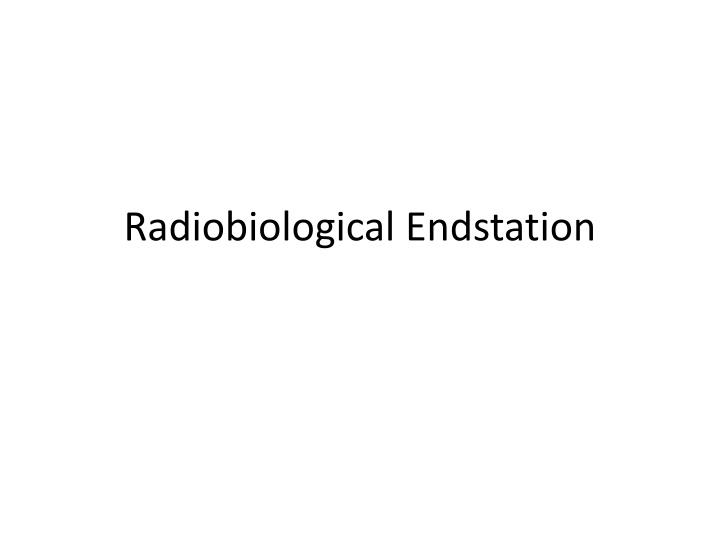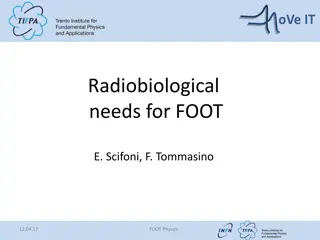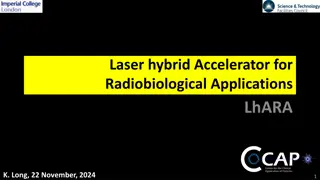Radiobiological Endstation
Research aims to compare proton sources from a hybrid accelerator, X-rays, and synchrotron protons in terms of effectiveness and damage patterns. Limitations in proton penetration depth are identified, and mitigation strategies involve experimenting with different materials. Preliminary proposals outline contributions and work packages for a multi-year project in radiobiological research.
Download Presentation

Please find below an Image/Link to download the presentation.
The content on the website is provided AS IS for your information and personal use only. It may not be sold, licensed, or shared on other websites without obtaining consent from the author.If you encounter any issues during the download, it is possible that the publisher has removed the file from their server.
You are allowed to download the files provided on this website for personal or commercial use, subject to the condition that they are used lawfully. All files are the property of their respective owners.
The content on the website is provided AS IS for your information and personal use only. It may not be sold, licensed, or shared on other websites without obtaining consent from the author.
E N D
Presentation Transcript
Aim Compare the protons genereated in the hybrid accelerator with a) photons (200 kV X-rays) and b) protons generated at MedAustron with a synchotron
Research Question 1 Are protons from the hybrid acc equally effective compared to synchotron acc protons? Analyses of Cell Survival after irradiation p+ Xray Gold standard method for the characterization of novel irradiation techniques/sources Irradiation response to multiple dose levels can be investigated at various levels of cell survival
Research Question 2 Is the damage pattern equal to synchotron acc protons given the same dose? Analyses of DNA double strand breaks after irradiation Efficacy as well as savety
Limitations Main problem: 5.6 MeV protons delivered by the hybrid acc Limitation of penetration depth to 0.5mm in water P+ will already stop in the approx 1-2 mm plastic of the cell culture flask
Mitigation Trying to grow cells on foile instead of plastic ongoing experiment at MedAustron 5.6 MeV will most likely not be enough, as also the foile has a certain thickness.
Preliminary Proposal Contributions M4.1: Equipping the facility for radiobiological research M4.2: Evaluation of cell survival after reference-, control-, and laser-accelerated ion irradiation. M4.3: Evaluation of DNA damage and damage clearance after reference-, control-, and laser- accelerated ion irradiation. M4.4: Evaluation of differential immunogenic signalling after reference-, control-, and laser- accelerated ion irradiation this endpoint is hard to plan for: if the problems with the energy etc can be overcome easily, the endpoint can be fullfilled, otherwise eventually not Workpackages (WP) Year 1 Year 2 Year 3 Year 4 Year 5 Q1 Q2 Q3 Q4 Q1 Q2 Q3 Q4 Q1 Q2 Q3 Q4 Q1 Q2 Q3 Q4 Q1 Q2 Q3 Q4 WP1: Laser-driven particle source WP2: Particle capture WP3: Beam transport and delivery M1 M2 M3 M4 WP4: Endstation for radiobiological research WP5 System integration WP6: Project management
experiment short description equippment X-ray referece irradiatior Cell culture bench Pump Incubator (37 C, 5% CO2) culture plates media and supplements depending on cell lines consumables (pipettes, tips, glassware, etc) cell counter comment requirments company price ( ) comment 200.000 available at MA require on site require on site necessary for culturing of cells and any following experiments require on site General requirements require on site require on site require on site Beckman Coulter 330 require on site only necessary when many experiments are planned, otherwise analyses by hand is feasible either 1 transmitted light and 1 fluorescence or 1 combined The cell survival after irradiation with the plasma-driven acc will be analysed at different dose levels (0.5 - 8 Gy). Resulting cell survival curve will be compared to a) reference irradiaiton (X-rays) and b) MedAustron proton and/or carbon results whole workstation including analysis software Colony Counter BioSpot 90.000 available at MA Cell Survival for RBE analyses required on site (transmitted light) Microscope Zeiss 3000 methanol (4L) crystal violet (25g) Thermo Scientific Thermo Scientific 151 100 required on site required on site has to be used if MedAustron Setup will be used - if not, other choices cna be made Nunc Lab-Tek Flask on Slide Thermo Scientific 442 required on site 4 % paraformaldehyde (1L) sodium dodecyl sulfate (25g) Triton X100 (100ml) > 99.8% Ethanol (2.5L) bovine serum albumine Carl Roth 10 required on site Sigma Aldrich 45 required on site Sigma Aldrich Sigma Aldrich Sigma Aldrich Jackson Immuno Research 45 70 38 required on site required on site required on site DNA damage will be analysed immediatly after irradiation and 24 hours later to compare the levels of non-repairable (hence complex) DNA damage after plasma-dirven acc, X-ray and MedAustron proton and/or carbon irradiation normal goat serum 45 required on site DNA damage analyses Rhodamine (TRITC)- conjugated AffiniPure Goat Anti-Mouse IgG anti-phospho-Histone H2A.X (Ser139) antibody Vectashield hardset with DAPI Axioimager fluorescence microscope with automated scanning system Metafer Jackson Immuno Research 173 required on site Millipore 512 required on site Szabo Scandic 205 required on site for automated foci counting MetaSystems 155.000 available at MA item can be used at MedAustron item is standard in any bio-research lab - please ask collaboration partners in-house if you can use it has to be purchased





